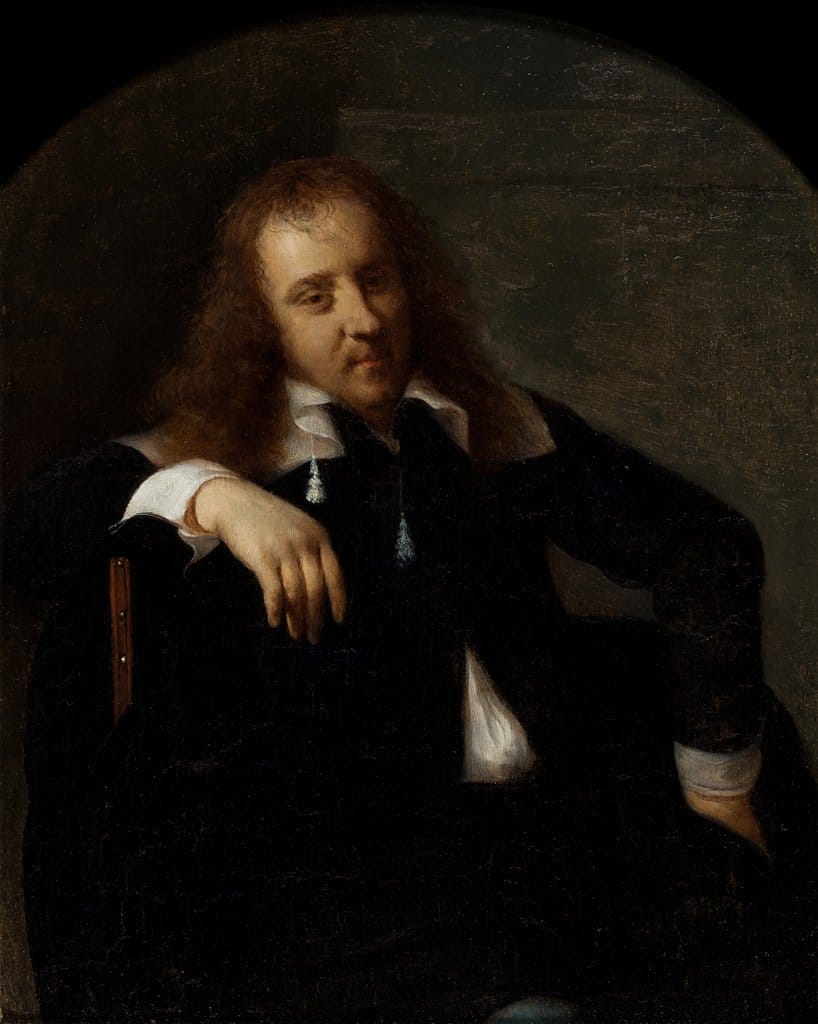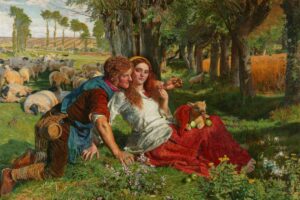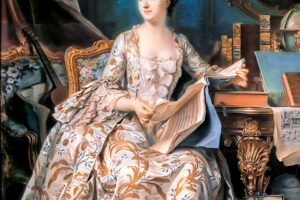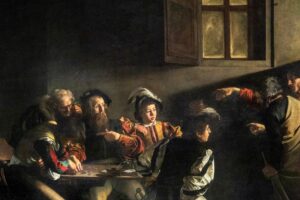Woman Reading a Letter
Gabriel Metsu, c. 1665–1667
The Scene Before Us
A quiet room bathed in natural light. A young woman sits at ease, absorbed in the letter she holds. Her soft expression reveals emotion—something between longing and joy. She wears an elegant orange gown trimmed with gold, a vivid blue cushion propped beneath her arm. Her gaze is distant, not on the words, but on what they mean. A nearby mirror on the wall catches a sliver of reflection, just enough to remind us this moment is fleeting, observed.
Beside her stands another woman, holding a pail in one hand and drawing back a vibrant green curtain with the other. Behind that curtain, a painting within the painting shows ships tossed in stormy seas. It’s a quiet contrast to the calm interior—an echo of distance, of waiting. At their feet, a small dog stands alert, paws raised toward the seated woman. Perhaps it senses her anticipation, or perhaps it simply wants her attention.
The tiled floor, the glowing colors, the domestic details—all lend the scene a realism and warmth that is typical of Baroque genre painting. Yet Metsu offers more than a charming domestic view. He offers a story.
The Deeper Meaning
Letters in 17th-century Dutch painting often signal love, longing, or separation. Here, the woman’s dress, the painting of stormy seas, and the attentive little dog suggest a story of waiting—a romantic letter, perhaps from a beloved far away, traveling by sea.
The servant, though engaged in her task, glances back as if curious. Her action of drawing the curtain has a theatrical feel, as though she’s revealing more than light—perhaps the drama that lies behind the letter’s arrival.
Metsu was known for his ability to blend storytelling with emotional nuance. In this painting, he gently invites us to witness a private moment: the intimate pause between reading and response, where emotion stirs quietly. No grand gesture is needed. The message is already received, and it has changed something in her.
A Moment Caught in Time
Metsu captures what so many genre painters of the Dutch Golden Age excelled at: life in its quiet beauty. The scene is both ordinary and rich with meaning—a moment of reflection, of hope, of imagined reunion.
Though centuries have passed, the sentiment remains familiar. The waiting, the reading, the wondering—all part of the timeless human experience of love and distance.
About Artist

Gabriel Metsu (1629–1667) was a prominent Dutch Golden Age painter celebrated for his intimate and refined genre paintings. A contemporary of Vermeer, Metsu’s work shares a similar focus on everyday domestic life, but with a more narrative and emotionally expressive style. He was a master of rendering textures, from the sheen of silk to the softness of fur, and his paintings are a meticulous record of the luxurious lives of the 17th-century Dutch elite.
Artistic Style and Influences
Metsu’s style was highly eclectic, absorbing influences from a variety of masters. He was likely trained by Gerrit Dou, and his early works show the influence of the “fijnschilders,” or fine painters, from Leiden, who were known for their highly detailed and polished technique. Later, after moving to Amsterdam, Metsu’s work developed a greater emotional depth and a more elegant, fluid style, drawing comparisons to painters like Gerard ter Borch and Johannes Vermeer. Unlike Vermeer’s often cool, detached scenes, Metsu’s paintings are more anecdotal and feel more connected to the viewer.
Notable Works
Metsu’s subject matter was diverse, but he is best known for his depictions of everyday life, often with a hint of romantic intrigue or moralizing subtext.
- “The Sick Child” (c. 1664-66): This powerful painting, considered one of his masterpieces, depicts a solemn mother holding her feverish child. The work is a moving study of human emotion and a departure from his more lighthearted genre scenes.
- “The Hunter’s Present” (c. 1658-61): A classic example of his “merry company” scenes, this painting shows a hunter presenting a dead partridge to a lady. The scene is full of subtle innuendo and social commentary, a common feature of Dutch genre painting.
- “Woman Reading a Letter” (c. 1664–1666): This painting is a prime example of his mature style. It is often paired with its companion piece, “Man Writing a Letter”. The painting depicts an elegantly dressed woman absorbed in reading a letter, while a maidservant stands discreetly in the background. The use of light and shadow, combined with the quiet moment of concentration on the woman’s face, creates an air of mystery and intimacy. The symbols within the painting, such as the little dog and the seascape painting in the background, hint at a romantic, possibly long-distance, relationship, inviting the viewer to create their own story.



